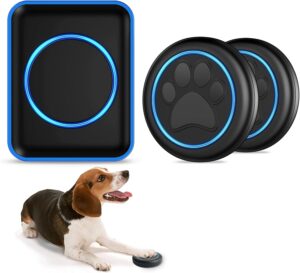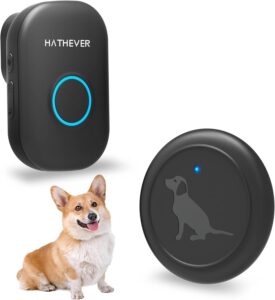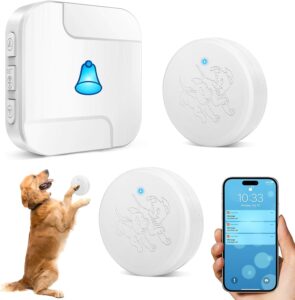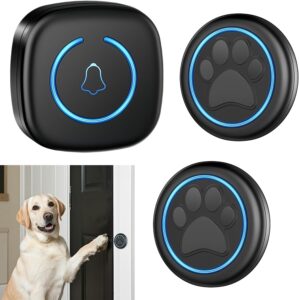The Genius of a Doorbell for Dogs: More Than Just a Ring

Introduction: A Doorbell for Dogs
Ever wanted your furry best friend to tell you when it’s time to go outside? Or is it once that delivery driver approaches? Well, guess what? There’s a way! Say hello to the delightful world of doggie doorbells. Now, I know what you’re thinking, a doorbell for a dog? Seriously? Believe that for this one, it’s not as bonkers as it sounds. Actually it can be a complete game changer for both you and your furry friend, offering another language between both species and a whole new understanding. You’re providing your dog with a way to communicate and let their wants and needs be known, without having to rely on chaotic barking or those heart-wrenching puppy-dog eyes (let’s face it, they still work sometimes!).
Why a Dog Doorbell Can Be a Game Changer
Put yourself in your dog’s position. They have needs, desires, and something they have to say, but they don’t speak our language. They can get frustrated if they can’t effectively communicate to us what’s happening. A dog doorbell is that essential bridge — that direct line of communication that can really make your life easier, not to mention your pooch’s.
Better Communication and Understanding
Just think of the relief of finally knowing exactly why your dog is barking. Is it a potty emergency? Do they hear something outside? Do they simply want a bit of fresh air and a sniff around? They have a bell on the door to announce their arrivals, so you can be prepared now and it can lead to greater understanding between the two of you. It’s like finally getting to say, “Hey, I need you!” in a fashion we can imaginatively follow.
EverNary Dog Door Bell, Wireless Doggie Doorbells
Reducing Accidents and Stress
Fact of the matter is, indoor accidents are a reality. There are times when our dogs can’t wait, or perhaps we’ve overlooked the subtle signs. A dog doorbell can help to minimize these occurrences. Giving your dog a clear and consistent way of letting you know when they need to go outside also give them more control and reduces the anxiety at having to “hold it” for too long. This also saves your carpets, and your pooch unnecessary stress.
Building Independence and Confidence
Assigning your dog a task — such as ringing a bell to go on a walk — can actually help add to their confidence and independence. They discover that by doing something, something positive happens – the door opens! This may be especially helpful for shyer or anxious dogs, as it provides them with a safe avenue to experience and make their way in the world. It’s empowering for them!
Convenience for Pet Parents
Fine, OK — it is also mega easy for us humans. No more hovering next to the back door, trying to figure out whether that little whine means “I need to pee” or “I saw a squirrel.” The doorbell is easy to be heard so you always know when someone is at the door. It can also be particularly useful during chaotic periods or when you’re working on something else.
A Look at the Various Dog Doorbells
Just as every dog has its day (with regard to the choice of collar or leash, anyway), there’s bound to be a right type of doorbell as well. Here are a few of the alternatives we found:
Physical Doorbells-The Old Way
These are the classic bells, usually strung on a wire or attached near the door. Your dog is taught to push or paw at the bell to get it to jingle. Simple and inexpensive and without need for batteries or a complicated setup. The downside? You may not even be able to hear them if you’re in another part of the house.
Something old, something new (fangled)
Like a human doorbell, these include a wireless button that your dog learns to push, sending a signal to a receiver in your home. These are usually available in a range of volume levels and chimes. These are a good choice if you need a louder signal or if you want to put the receiver in a certain spot.
Wireless Paw-Activated DoorBells
These are made just for dogs, often with a sizable, paw-friendly pad that announces a wireless signal once your dog puts paw to pad. They may be a good choice for dogs who don’t understand the concept of nudging or pushing a button. But you’ll have to make sure your dog can’t accidentally set it off just by walking past.
Training Bells: The Simple, But Effective, Choice
While not an actual “doorbell,” it’s still a highly popular approach. Those usually consist of a pair of bells attached to a strap that you lay next to the door. Your dog can learn to ring the bells with a paw or nose to let you know it’s time to go outside. They’re cheap and easy to practice with.
The Right Doorbell for Your Little Buddy
So, with all of these choices, how do you choose the best one for your four-legged friend? Here are some important things to consider:
Thinking About Your Dog’s Size and Breed
An itty bitty Chihuahua may struggle to hit a physical bell that’s mounted high, and a big ole Lab could accidentally trip the paw-pad doorbell in all his excitement. Keep in mind the size and effort level of your dog when deciding which ball to go with.
Evaluating Your Dog’s Temperament and Learning Style
Does your dog love to please and is he/she quick to learn new things? Or are they being more delicate and need a more gentle touch? Some dogs might instantly grasp a push-button doorbell, while others might appreciate the simplicity of training bells.
Assess Where You Live
If you live in a two-story, multi-story building, sometimes you may not be able to hear a low bell sound. Or is your area small and walking around an big electronic receiver could be unwieldy? Keep the layout of your home and your lifestyle in mind when shopping for a doorbell.
Budget and Installation Inclusions
Priced from a few dollars for simple training bells to higher-end electronic options, dog doorbells have a variety of costs. Also consider the process of installing them. How easy are you with DIY (or how easy do you want it to be to set up)?
How to Train Your Dog to Use a Doorbell: A Step-by-Step Guide
OK, you have picked your doorbell. Now for the fun part: teaching your dog to use it! Patience and positive reinforcement will be your friends here.
Introduction and Positive Correlation
Allow your dog to sniff and investigate the doorbell. Turn it into a pleasant experience for them so that they associate it with treats and praise just for being there. You want them to learn to love the sound of the doorbell.
The “Touch” Command
Begin by training your dog to touch the doorbell with their nose or paw when given a command. With your dog at the bell, use a treat to get their nose or paw on the bell, and as soon as they touch, say a cue word like “touch” or “ring” and the moment they ring the bell, reward them with a treat and excited praise. Do this a few times for no more than a few minutes.
Moving to the Door
When your dog knows the touch cue, you can introduce the doorbell: Move the doorbell into position next to the door you want to use when your dog has to go to the bathroom. Teach the “touch” command at the door and reward your dog evertime he touches the doorbell.
Generalization and Consistency
Next, attach the doorbell to going outside. Right before you take your dog outside for a potty break, have them “touch” or “ring” the doorbell. Quickly open the door and let them go . Don’t ask them to ring it when they return inside. The idea is for them to associate ringing the bell with going outside. It’s crucial that you adhere to this routine each and every time.
Common Issues and How to Resolve Them
Some dogs may be shy at first, while others may get a bit too excited and ring the bell for attention all the time. If your dog is reluctant, keep the sessions short and sweet. Over time, if they’re ringing it a lot, ignore the rings that don’t directly follow a real stretch of time urgently needing to go outside. Only open the door for potty when they ring it and need to go.
The benefits aren’t just for potty breaks
While a lot of people purchase a dog doorbell for potty training, there are actually many other advantages that can come out of it!
Used to Signal Other Needs and Wants
Once your dog has the concept of using the doorbell to alert you down pat, he may start using it to communicate other wants or needs, such as wanting to go for a walk, wanting his water bowl refilled, and, from time to time, expressing the desire to take a little nap outside. It’s an entirely new channel for them to express their desires.
Signaling at Visitors or Sounds
Some dogs can be taught to ring a doorbell when they hear someone coming to the door or when they hear a particular sound outside. This can be especially useful for a dog that is naturally more alert or for one that you want to train as a discreet early warning system.
Fostering a Stronger Bond
In the end, a dog doorbell is a clear form of communication and there’s no denying, communicating clearly brings you and your pet closer. It’s a sign to them that you are listening, and that you care about their efforts to communicate with you.
Discussion of Possible Concerns and Misconceptions
I know, you may still have some reservations or questions. Let’s take on a few of the most common ones:
Will My Dog Become Demanding?
Although a dog could learn to ring a doorbell or bark for attention (and there are fancy pet products that do just that), regular training with the doorbell minus unnecessary response or reinforcement should prevent this. It’s just about setting clear boundaries and they will bang only when they really need to leave.
Is it Difficult to Train?
The vast majority of dogs can be taught to ring a doorbell with some patience and consistently applied positive reinforcement. The secret is to take it step by step and to have it as an enjoying and rewarding experience.
What if I Have Multiple Dogs?
You may have multiple dogs and want to teach them all the same trick. You may have to police their use of the doorbell at first to prevent one dog from perpetually ringing it for others.
Incorporating the Doorbell into Your Dog’s Day
Broach and SuttonMyRussound BRO-DJ Door Bell Button White – Compatible with the MRC-88 and all “C, ” FAST (MyRussound) Delivery : Best point about this function is it won’t spoil the appearance of your door wood so whenever you use inexpensive wood it can blend in perfectly and doesn’t look ugly, very easy to deride conducted as needed and practice perfectly for routing conduct fittings.
Consistency is Key
Ring the doorbell each and every time you go outside with your dog. This will enable them to reinforce the connection between ringing the bell and the door opening.
Reinforcement through The use of rewards and reinforcement.
Over time, remember to praise and reward your dog for using the doorbell correctly. This serves to reinforce the behavior and make the individual more likely to use the behavior again.
Patience and Understanding
Rest assured that all dogs learn at their own pace. Be patient with your pet and revel in the mini-wins along the way. Yes, there will be regressions, but if you keep at it regularly, they’ll get it.
Doorbell Mastery Pro Tips
Advanced tips Once your dog has learned the basic language, there are a few advanced tips to try:
Location of The variations
If you have more than one door your dog uses, you can teach them to use a doorbell at each. This can be very useful if you have a lot of property to cover.
Alternating Sounds or Signals
For however you are notified to the knock, you might also be able to train your dog to correlate different chimes with different types of needs (although that is a bit more advanced of a behavior to teach).
Integration with Other Communication Techniques
Your dog shouldn’t be able to let a doorbell be the only way he communicates. You can still pay attention to their other signals, their body language. That doorbell is just one more valuable tool in your toolbox of communication.
Dog Communication Technology of the Future
The pet tech space is evolving all the time, and who knows what the future holds for canine communication!
Best Video Doorbells With Extras
Imagine “smart” doorbells that not only tell you when your dog has rung but send you video showing you why they’re at the door! Or systems that learn your dog’s habits and can anticipate when it will need to go out.
Wearable Tech for Increased Comprehension
Dog-friendly wearables are getting smarter. Some day, maybe we’ll have machines that translate all those woofs and whines that our dogs use to communicate with into something we can understand even more clearly than we do now.
Success Stories in Real Life Dogs And Their Doorbells
Trust me, the concept works! I have heard so many success stories from pet parents whose lives have changed for the better after teaching their dogs to use a doorbell. The advantages are real and tangible, from reducing accidents in senior dogs to offering a reliable method of shy pups communicating. It is as much about empowering our dogs as it is the peaceful coexistence in the home.
Dog Door Bell for Potty Training, Smart Wireless Doggie Doorbell to Go Outside
DIY Dog Doorbell Variations: Thinking outside the box
You don’t even have to buy a fancy electronic system. And for the homebodies, you can get inventive with a DIY option! They’re tied to a simple string of jingle bells, which can be just as effective as a store-bought option, especially when in the early stages of training. The point is consistency and positive reinforcement, not the cost of the doorbell.
About Doorbells for Your Doggies.Keep Your Doggy Doorbel in a Good Performance
Your dog’s doorbell can need a bit of maintenance! For real bells, be sure they’re securely attached & easy for your dog to get ahold of. For electronic systems, inspect the batteries often. As I continue to take that advice to heart and work to make my doorbell last as long as possible for my furry, four-legged companion your doorbell will too!
Wrapping It Up: Let Your Dog Tell You What It Wants
But a dog doorbell is so much more than a novelty — it’s a robust communication device that can improve communication, lower stress, and create a stronger bond between you and your furry BFF. When you give your dog a clear consistent means to communicate their needs, you’re giving them a voice and building an understanding, positive, and fulfilling relationship. So, why not consider giving your furry friend the gift of speech? There’s often much more under the surface than you think.
FAQs - Frequently Asked Questions
How long to train a dog to use a doorbell? Well, it very much depends on the dog. A few superfast learners might catch on in days, while others might need a few weeks of regular training. The secret is brief, upbeat training sessions and plenty of patience. If it doesn’t happen overnight, don’t be discouraged!
What if my dog barks at the doorbell instead of hitting it? That’s a common hurdle! If your dog is barking at the sound of the doorbell, redirect the behavior. When they start barking, gently direct their nose or paw to the bell and reward the instant they touch it. You’re looking to connect the touch with the goodie, not the bark.
My dog has trained me to ring the doorbell when I need to go out to play. How do I stop this? Ah, the clever manipulator! In order to accomplish this, only open the door when they ring the bell if you truly feel they have to use the toilet. Even if they do, send them back inside. They will soon find that ringing the bell means potty time, not playtime on demand.
What Kind of Doorbell Is Most Suitable for a Small Breed Dog? If you have smaller dogs, you might find that physical bells that hand low or electronic push-button doorbells with an easily-pushed button might work best. Training bells are also great as they take very little pressure to ring.
Can an older dog learn to ring a doorbell? Absolutely! You can teach an old dog new tricks! Older dogs may need a little more time to catch on, but with time, consistency and positive reinforcement, they can certainly learn to use a doorbell. And it can be especially helpful for older dogs that might need a potty break more urgently.











